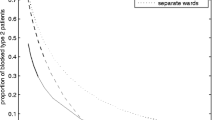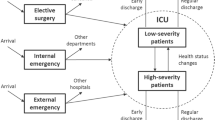Abstract
This paper examines a decentralized admission control system with partial capacity sharing in a hospital setting. The admission decision is made by each physician who is assigned a number of dedicated inpatient beds. A physician can “borrow” beds from other physicians if his dedicated beds are all occupied. We seek to understand the impact of the “borrowing cost” on physicians’ admission behavior. We find that (i) If the borrowing cost is low, a physician tends to admit lower-risk patients when either his or others’ capacity utilization is higher; (ii) If the borrowing cost is moderate, a physician tends to admit higher (lower)-risk patients when his (others’) capacity utilization is higher; and (iii) If the borrowing cost is high, a physician tends to admit higher-risk patients when either his or others’ capacity utilization is higher. We then empirically test and validate these findings. Our work demonstrates that when designing strategic admission control systems, it is important to quantify and perhaps then influence the magnitude of the borrowing cost to induce a proper level of competition without sacrificing the benefit of resource pooling.




Similar content being viewed by others
References
National Statistics Bureau: National Bureau of Statistics of China 2015. National Bureau of Statistics, Beijing (2016)
Shanghai Statistical Bureau: Shanghai Statistical Yearbook 2017. Shanghai Statistical Bureau, Shanghai (2017)
Bekker, R., Koeleman, P.M.: Scheduling admissions and reducing variability in bed demand. Health Care Manag. Sci. 14(3), 237 (2011)
Monks, T., Worthington, D., Allen, M., Pitt, M., Stein, K., James, M.A.: A modelling tool for capacity planning in acute and community stroke services. BMC Health Serv. Res. 16(1), 530 (2016)
MacStravic, R.E.S.: Admissions scheduling and capacity pooling: minimizing hospital bed requirements. Inquiry 18(4), 345–350 (1981)
Teixeira, A., De Oliveira, M.: Operations research on hospital admission systems: a first overview of the 2005–2014 decade. J. Phys. Conf. Ser. 616, 012009 (2015)
Dranove, D.: Demand inducement and the physician/patient relationship. Econ. Inq. 26(2), 281–298 (1988)
Yip, W.C.: Physician response to medicare fee reductions: changes in the volume of coronary artery bypass graft (CABG) surgeries in the medicare and private sectors. J. Health Econ. 17(6), 675–699 (1998)
Shmueli, A., Sprung, C.L., Kaplan, E.H.: Optimizing admissions to an intensive care unit. Health Care Manag. Sci. 6(3), 131–136 (2003)
Kim, S.H., Tong, J., Peden, C.: Admission control biases in hospital unit capacity management: how occupancy information hurdles and decision noise impact utilization. Manag. Sci. 66(11), 5151–5170 (2020)
Kolesar, P.: A Markovian model for hospital admission scheduling. Manag. Sci. 16(6), B-84 (1970)
Powell, A., Savin, S., Savva, N.: Physician workload and hospital reimbursement: overworked physicians generate less revenue per patient. Manuf. Serv. Oper. Manag. 14(4), 512–528 (2012)
Freeman, M., Savva, N., Scholtes, S.: Gatekeepers at work: an empirical analysis of a maternity unit. Manag. Sci. 63(10), 3147–3167 (2016)
Kc, D.S., Terwiesch, C.: Impact of workload on service time and patient safety: an econometric analysis of hospital operations. Manag. Sci. 55(9), 1486–1498 (2009)
Jack, E.P., Powers, T.L.: A review and synthesis of demand management, capacity management and performance in health-care services. Int. J. Manag. Rev. 11(2), 149–174 (2009)
Kumar, A., Ow, P.S., Prietula, M.J.: Organizational simulation and information systems design: an operations level example. Manag. Sci. 39(2), 218–240 (1993)
Green, L.: Queueing analysis in healthcare. In: Patient Flow: Reducing Delay in Healthcare Delivery, pp. 281–307. Springer, New York (2006)
Gedik, R., Zhang, S., Rainwater, C.: Strategic level proton therapy patient admission planning: a Markov decision process modeling approach. Health Care Manag. Sci. 20(2), 286–302 (2017)
Tsai, P.F., Lin, F.M.: An application of multi-attribute value theory to patient-bed assignment in hospital admission management: an empirical study. J. Healthc. Eng. 5(4), 439–456 (2014)
Kim, S.H., Chan, C.W., Olivares, M., Escobar, G.: ICU admission control: an empirical study of capacity allocation and its implication for patient outcomes. Manag. Sci. 61(1), 19–38 (2014)
Park, S., Lee, J., Ikai, H., Otsubo, T., Imanaka, Y.: Decentralization and centralization of healthcare resources: investigating the associations of hospital competition and number of cardiologists per hospital with mortality and resource utilization in Japan. Health Policy 113(1–2), 100–109 (2013)
Song, H., Tucker, A.L., Murrell, K.L.: The diseconomies of queue pooling: an empirical investigation of emergency department length of stay. Manag. Sci. 61(12), 3032–3053 (2015)
Hackman, J.R., Oldham, G.R.: Motivation through the design of work: test of a theory. Organ. Behav. Hum. Perform. 16(2), 250–279 (1976)
Cavalieri, M., Ferrante, L.: Does fiscal decentralization improve health outcomes? Evidence from infant mortality in Italy. Soc. Sci. Med. 164, 74–88 (2016)
Lin, K.Y.: Decentralized admission control of a queueing system: a game-theoretic model. Naval Res. Logist. (NRL) 50(7), 702–718 (2003)
Dong, J., Shi, P., Zheng, F., Jin, X.: Off-service placement in inpatient ward network: resource pooling versus service slowdown. Columbia Business School Research Paper Forthcoming (2019)
Song, H., Tucker, A., Graue, R., Moravick, S., Yang, J.: Capacity pooling in hospitals: the hidden consequences of off-service placement. Manag. Sci. 66(9), 3825–3842 (2020)
Dai, J., Shi, P.: Inpatient overflow: an approximate dynamic programming approach. Manuf. Serv. Oper. Manag. 21(4), 894–911 (2019)
Aumann, R.J., Hart, S.: Handbook of Game Theory with Economic Applications. Elsevier, North-Holland (2002)
General Office of the Ministry of Health: Notice of the general office of the ministry of health on printing and distributing the measures for surgery grading administration in medical institutions (trial). http://www.nhc.gov.cn/wjw/ywfw/201306/def185b8d52e48918cf7e12e43e956d6.shtml (2013). Accessed 1 Oct 2021
Chinese Burn Association and others: Expert consensus on classification evaluation methods of burn surgery in China (2019 version). Chin. J. Burns 35(11), 769–771 (2019)
Hu, J., Su, Q., Wang, Q., Wang, Q.: A surgery scheduling model based on surgery grading management system. In: 2017 International Conference on Service Systems and Service Management, pp. 1–4 (2017)
Horn, S.D., Horn, R.A.: Reliability and validity of the severity of illness index. Med. Care 24(2), 159–178 (1986)
Brewster, A.C., Jacobs, C.M., Bradbury, R.C.: Classifying severity of illness by using clinical findings. Health Care Financ. Rev. 1984(Suppl), 107–108 (1984)
Horn, S.D., Horn, R.A., Sharkey, P.D., Chambers, A.F.: Severity of illness within DRGs: homogeneity study. Med. Care 24(3), 225–235 (1986)
Brewster, A.C., Karlin, B.G., Hyde, L.A., Jacobs, C.M., Bradbury, R.C., Chae, Y.M.: Medisgrps®: a clinically based approach to classifying hospital patients at admission. Inquiry 22(4), 377–387 (1985)
Lyandres, E., Fu, F., Li, E.X.: Do underwriters compete in IPO pricing? Manag. Sci. 64(2), 925–954 (2018)
Huckman, R.S., Pisano, G.P.: The firm specificity of individual performance: evidence from cardiac surgery. Manag. Sci. 52(4), 473–488 (2006)
Author information
Authors and Affiliations
Corresponding author
Additional information
This work was supported by the National Natural Science Foundation of China (Nos. 71720107003, 72033003 and 71722008)
Appendix
Appendix
Our empirical analyses have several subjective definitions: the criteria of filtering samples, the construction of the dependent variable \(R\_\textit{grade}\), and the construction of the independent variables \(\textit{Self}\_\textit{State}\) and \(\textit{Others}\_\textit{State}\). In this appendix, we will show that our findings are robust under alternative definitions.
1.1 Different criteria of filtering samples
In Sect. 4.1, we use the median number of daily occupied beds 77 as a filter and focus on patient admissions when at least 77 beds are already occupied. We show in Table 7 our main results continue to hold when the number used to filter samples takes values from 75 to 80.
1.2 Different criteria to construct the dependent variable
In Sect. 4.2, we use \(R\_\textit{grade}\) as a proxy for a patient’s medical risk. Here, we use an alternative criterion to test the robustness of our results. We define four buckets where the buckets are partitioned in such a way that the four buckets are patients with total surgery grades in [0, 5), [5, 6), [6, 9) and [9, 16], respectively. Table 8 shows that our empirical results are robust under the alternative definition.
1.2.1 Different criteria to construct independent variables
To check the robustness of cutoff point of \(\textit{Self}\_\textit{Load}\), we fixed the cutoff point of \(\textit{Others}\_\textit{Load}\) is fixed at quantile 0.9. In Table 9, our main conclusion continues to hold when the cutoff point of \(\textit{Self}\_\textit{Load}\) takes values from 0.4 to 0.7.
Similarly, when check the robustness of cutoff point of \(\textit{Others}\_\textit{Load}\), we fix the cutoff point of \(\textit{Self}\_\textit{Load}\) at quantile 0.6. In Table 10, our main conclusion continues to hold when the cutoff point of \(\textit{Others}\_\textit{Load}\) takes values from 0.6 to 0.9.
Rights and permissions
About this article
Cite this article
Zhao, YY., Yu, PW. & Hu, JQ. Strategic Admission Behavior and Its Implications: Evidence from a Cardiac Surgery Department. J. Oper. Res. Soc. China 11, 29–49 (2023). https://doi.org/10.1007/s40305-021-00377-2
Received:
Revised:
Accepted:
Published:
Issue Date:
DOI: https://doi.org/10.1007/s40305-021-00377-2
Keywords
- Decentralized control system
- Admission policy
- Beds sharing
- Strategic behavior
- Dynamic programming
- Empirical study




